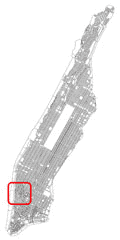|
|
Public Art:
The above map illustrates some of the many great public works of art that have been installed in the Greenwich Village and SoHo area. The red line is a suggested walking tour to view some of these impressive works.
|
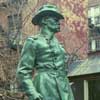 |
1. General Philip Henry Sheridan
Sculpted by Joseph P. Pollia, the standing figure of General Sheridan is cast in bronze and stands on a conway green granite plinth. Cast in 1936, and dedicated on October 19th by the Roman Bronze Works foundry, the statue is in memory of, and dedicated to Kenneth S. Seewald.
|
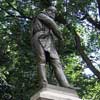 |
2. Giuseppe Garibaldi
Giovanni Turini's statue of Giuseppe Garibaldi was donated by New York's Italian-American American community and dedicated in Washington Square Park in 1888, the sixth anniversary of Garibaldi's death. General Giuseppe Garibaldi (1807-1882) was a 19th century Italian patriot who crusaded for a unified Italy during the European era of state building.
|
 |
3. George Washington, Alexander Calder
This elaborate marble statue depicts American Revolutionary War General and President George Washington (1732-1799). Standing in stately repose before human personifications of wisdom and justice, the 16-foot marble figure in high relief on integral plinth was sculpted by Alexander Stirling Calder (1870-1945). Alexander Calder came from a family of sculptors and artisans. Educated both at the Pennsylvania Academy of Fine Art (1886-90) and in Paris (1890), he was well-known for his public works. He also sculpted the Swann Memorial in Philadelphia, Pennsylvania, monumental archways in Pasadena, California, and the Depew Memorial Fountain in Indianapolis, Indiana.
|
 |
4. The Family, Chaim Gross
Chaim Gross' sculpture, The Family, was created in 1979 and donated to the City of New York in 1991 in honor of former Mayor Edward I. Koch. Gross spent most of his career working with wood until the 1950's when he began to sculpt in bronze. Heavily influenced by Chagall, he mostly sculpted dancing figures.
|
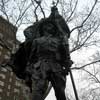 |
5. The Abingdon Doughboy
This sculpture honors those servicemen from the neighborhood of Greenwich Village who gave their lives while serving in combat during World War I. The dramatic bronze statue on a granite pedestal, dedicated in 1921, is by Philip Martiny (1858-1927), and depicts a foot soldier (known commonly in World War I as a "doughboy") holding a swirling American flag in battle.
|
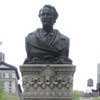 |
6. Alexander Lyman Holley
Dedicated "In Honor of Alexander Lyman Holley Foremost Among Those Whose Genius and Energy Established in America and Improved Throughout the World The Manufacture of Bessemer Steel This Memorial is Erected by Engineers of Two Hemispheres" Alexander Lyman Holley (1832-1882) was born in Lakeville, Connecticut, and died in Brooklyn. He is known best for adapting the Bessemer process of steel-making to U.S. needs, Holley had a brilliant and versatile mind. His work immediately brought rapid production to ironworks and rolling mills, along with a high standard of excellence, and his efforts significantly reduced steel prices and enabled unprecedented growth in the industries that moved America forward, including railroads, bridges, and ships.
|
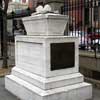 |
7. Firemen's Memorial
A large, rectangular marble sarcophagus on the north side of the James J. Walker park, dedicated in 1834 to three fallen firemen, serves as the only reminder of this areas former role as a cemetery. From 1812 to 1895, the park area served as St. John's Cemetery, the burial ground of Trinity Church. Parks acquired the land in 1895. Originally called St. John's Park, the name changed to Hudson Park by 1896, for the bordering street to the west. Architects Carrere and Hastings provided an elegant park design, which included a sunken garden, lagoon, perimeter walk, and gazebo. In order to provide space for active recreation, a new playground open in 1903.
|
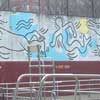 |
8. Carmine Street Pool Mural, Keith Haring (1958-1990)
This mural was painted in August 1987 by famed graffiti artist Keith Haring (1958-1990) on the wall that adjoins the Carmine Street Pool at the James J. Walker Park handball court. Measuring 18 feet high by 170 feet long and taking its cue from the hues of the pool's underwater surface, the mural depicts bold, stylized motifs of fish and children as well as abstract shapes in black, white, yellow and blue.
|
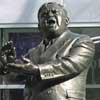 |
9. Fiorello H. La Guardia, Neil Estern
Unveiled in 1994, this dynamic sculpture of Mayor Fiorello H. La Guardia is by Neil Estern. La Guardia, the son of a United States Army bandleader, was born on December 11, 1882, at 177 Sullivan Street . In 1933, La Guardia, later nicknamed "Little Flower", (translation of fiorello) was elected mayor on a reform Fusion ticket following the scandals that had forced Mayor James J. ("Beau James") Walker (1881-1946) from office. He was inaugurated on New Year's Day 1934. Over the next 12 years, La Guardia left his distinctive mark on City politics. He unified the public transit system, consolidated and centralized much of City government, cracked down on illegal gambling, and constructed numerous bridges, parks, and airports. He appointed Robert Moses (1888-1981), the first commissioner of a unified Parks Department in 1934, and embarked on an unprecedented expansion of the New York City parks system throughout the 1930s and early 1940s. During his third term, 1942 to 1945, Gracie Mansion became the official residence of New York City's mayors. Also born in New York City, Neil Estern earned his reputation as a portrait, figure, and monument sculptor whose subjects were political and entertainment figures and commemoration of significant persons. His depictions include Danny Kaye, President Jimmy Carter, J. Edgar Hoover, J Robert Taft, Prince Charles, Lady Diana, Eleanor Roosevelt, and Jack Nicholson.
|
 |
10. Bust of Sylvette, Pablo Picasso (1881-1973)
In the courtyard green of I.M. Pei's University Village stands an 60-ton concrete enlargement of a Picasso's sculpture, Bust of Sylvette (1934), executed by Carl Nesjar (1967). The cubist sculpture combines a profile and frontal view of Sylvette's head, neck and shoulders. In it's original form it was a small, painted sheet-metal maquette.
|
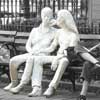 |
11. Gay Liberation Monument, George Segal
This sculpture by George Segal (1924-2000) honors the gay rights movement and commemorates the events at the Stonewall Inn opposite this park that gave rise to the movement. Segal's conception for Gay Liberation is typical of his work. Four figures - two standing males and two seated females - are positioned on the northern boundary of the park, in natural, easy poses. Using a process in which bronze casts are made from plaster moulds from the human models, Segal tempers the realistic surfaces with an unearthly white-painted finish. The result is specific, evocative, and understated, showing the public comfort and freedom to which the gay liberation movement aspired.
|
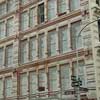 |
12. Cast Iron Facade Mural, Richard Haas
Cast iron facade mural by Richard Haas. This mural on the side of a building overlooking an empty lot used for an open air market, is of the likeness of other cast iron facades in the now famous area known for them.
|
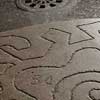 |
13. Sidewalk Art, Keith Haring
Sidewalk art dated 1984 by the late Keith Haring at the NW corner of Prince and Broadway in SoHo. The sidewalk granite slab is carved in the typical style of the artist.
|
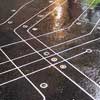 |
14. Subway Map, Francoise Schein
Schematic subway map embedded within the sidewalk titled "Subway Map Floating on a New York Sidewalk," created in 1986 by Francoise Schein, a Belgian artist and architect, who now lives in Paris. The schematic runs the length of the building -- 87 feet -- and is 12 feet wide. The IRT, BMT and IND are represented by half-inch-wide stainless-steel bars embedded in concrete, with lights indicating SoHo-area subway stops. The project cost an estimated $30,000 to produce and won the City Art Commission award for the best art project that year. But Ms. Schein's interpretation isn't a match for the M.T.A.'s -- she combined old and new maps to fit the space. And it won't get you out of Manhattan. "I couldn't fit Brooklyn or Queens on the sidewalk," she said at the time.
|
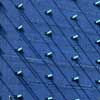 |
15. The Wall, Forrest Myers
The Wall , the 1973 Forrest Myers mural at the intersection of Broadway and Houston in NYC. This giant blue-painted installation was pulled down around 2003 during a legal dispute, but it was recently put back up around 2007. (One story higher, actually, so the building's owners could use the space below for billboards.)
|
|
|
|
|
|
|
|

